YOUR BUSINESS AUTHORITY
Springfield, MO
YOUR BUSINESS AUTHORITY
Springfield, MO

L&W Industries has been manufacturing and distributing railroad signal and communication products for 55 years. The signal cantilever joined its portfolio in the past decade, and though it’s somewhat of a newcomer for the company, officials say it’s an essential product for its customers to ensure proper communication and safety.
SBJ: How did production of the signal cantilever come about and what’s been the impact on your company and the industry?
Jenny Carr: We started buying these structures from a business partner. He had over 25-30 years of experience in designing and manufacturing these. It’s a niche market. Every one is custom designed. In 2014 was our first sale with him. That company was wanting to get out of it, because they had a little different focus, so we bought the company in 2018, and brought him along to ensure a successful transition.
SBJ: Who are your customers and how do you get the product in front of them?
Carr: We sell to what we consider Class 1 railroads – some of them would be BNSF, Union Pacific, Canadian National. We also sell to what we call short lines or Class 3 railroads. Sometimes we’ll do the whole entire package. That’s more on the crossing side.
SBJ: What’s the function of the cantilever?
Carr: There are signal cantilevers and signal bridges, and those two products are used when a railroad has multiple tracks. It looks like traffic lights that serve as communication to the trains entering. It will direct the train. Those communication standards are unique to each of the railroads. The related product would be the crossing cantilever and the crossing bridge, and those are the ones people are most familiar with. That would be when you go up to a railroad crossing.
SBJ: Where do you manufacture the cantilevers?
Carr: We have a 50,000-square-foot building in the industrial park, east, and a 35,000-40,000-square-foot building where these products are built. We’re busting at the seams. We looked at an expansion here, but we were landlocked. We found a building in Strafford and look forward to getting into that building as early as May. It’ll increase our capacity. It’s a new building ... with Rich Kramer, who built the building we’re in here.
SBJ: How many are you selling a year?
Carr: It’s pretty volatile. They’re unique, so they’re ordered, designed, engineered and manufactured really one at a time. There was one instance where we had seven bridges that were all identical, but that’s more the exception. We have three in the pipeline and a lot of different quotes out there, some we’re certain we’re going to get.
SBJ: Why is it important to make the product in the Ozarks?
Carr: Being located in central Missouri is very beneficial when you’re shipping all over the place. It’s also really nice that BNSF has a location here. Springfield has a very rich railroad history. We try to buy everything we can that’s made in the U.S. or as local as we can get it. Having a strong manufacturing base is vital for the Midwest in terms of the number of jobs manufacturers create and the trickle-down effect we see with suppliers locally. I think it’s vital to national security. We’re seeing a lot of onshoring, where some businesses are bringing their manufacturing plants closer to eliminate supply chain problems.